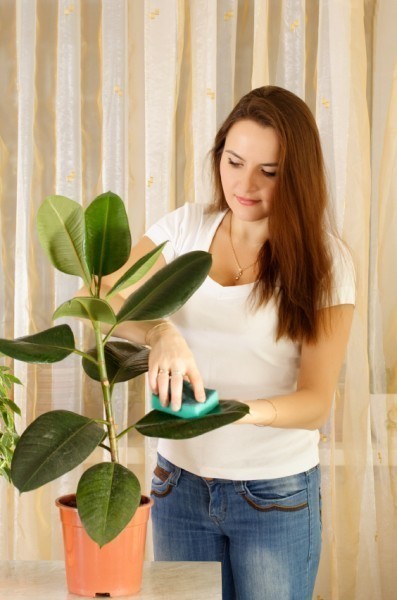






Houseplants become dirty or tangled without regular grooming. This will greatly reduce the attractiveness of your indoor gardens if you don’t watch out. Grooming and cleaning your houseplants is an important part of their care.
Dust diminishes the ability of the leaves to function. The leaves need to breathe in order to grow. Dust will block the breathing pores (stomata) and reduce the amount of light that can feed the growth-activating cells within the leaves.
Many houseplants are kept and grown specifically for their beautiful leaves. If the leaves become dirty or damaged, it takes away from the beauty of your indoor garden. Cleaning their leaves, then, is very important, and the way to do that depends on the texture of the leaf.
Non-chalky, clean soft water is perfect for cleaning leaves. If you live in an area where you have hard water, you can use rainwater or tap water that has been boiled. You can also use milk, vinegar or beer, but these things don’t shine the leaves. Olive oil is sometimes also recommended, but it does retain dust, which will damage leaves in the long run. There are also commercial leaf-cleaning products out there. These work well, too.
Dead or misshaped leaves can also ruin the look of a houseplant. You can cut out damaged leaves along with misplaced plant shoots. When overzealous stems ruin the plant’s shape, you can use sharp scissors to cut them back to just above a leave-point. All you have to do is cut out the dead leaves, but don’t leave small snags that will die back. If the dead leaves are located at the top of the shoot, you will best remove them by using sharp scissors and cutting the stem back to its base.
You can pick off the dead flowers on houseplants individually and place them on a compost heap. Azaleas produce many flowers over a period of weeks. As the first ones die, pick them off to allow for the next ones to grow. This is called deadheading. When you deadhead a cyclamen, you can pull off each dead flower together with the stem. If you just give it a tug, it will snap off where you want it to. If you were to only remove the flower, the stem would slowly decay and encourages other flowers and stems to decay along with it. It also just looks bad. Place the flowers and the stems on the compost heap; don’t leave them at the base of the plant.
Climbing plants need support and training to look good. Training and supporting the growing vines will help prevent stems from sprawling and becoming tangled. Splint canes and plastic mesh frameworks are ideal for this. However, if you have pink jasmine (Jasminum polyanthum), it has more appeal visually when cut and supported in a loop or heart shape.
You can use small trellises to support those climbing plants you don’t want to shape. Again, place them toward the side of the pot so you don’t damage the plant roots and weave the longer shoots through the trellis. This is a very attractive thing once the plant is trained the way to grow on its own. The only thing you’ll have to do is perhaps guide a few wayward strands.
It’s simply not hard to create beautiful indoor gardens when you pay attention to the plant needs. Further, by adding a few interesting things to the pots to help them grow, your garden will thrive beautifully for years to come.
Copyright © www.100flowers.win Botanic Garden All Rights Reserved